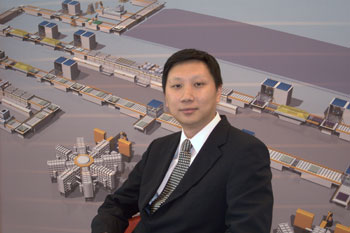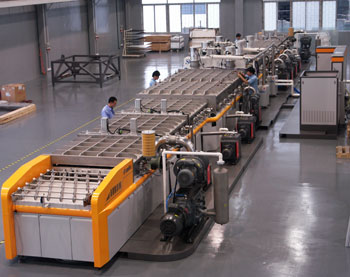
SOLAR ENERGY as a viable alternative to fossil fuels is moving toward “tipping point”, as cost per solar watt nears US$1.
That’s why the only capital goods maker listed on SGX, Anwell Technologies, is jumping on the solar power bandwagon.
”Solar cell production is expected to grow 25%-45% a year,” said its CEO Franky Fan to NextInsight in a telephone interview this week.
The capital goods maker expects to deliver its first production line for “Thin-Film” solar modules to Brazil Energy, an investor in energy producers.
"Brazil Energy approached us because of our strong presence in South America, where we have a 30% market share for DVD-R capital equipment," says Franky.
”Solar technology has similarities to that for optical discs,” he explains, when asked about strategy in new business lines.
Anwell was the world’s largest DVD-R capital goods maker last year and shipped out its first Blu ray disc production line in 4Q07.
Makers of conventional (crystalline) solar cells are rushing to produce new breed “Thin-Film” solar cells, which use less than 1% of silicon light absorbers compared to the former.
There are 80 “Thin-Film” solar capital goods makers today.
Leading the pack is semi-conductor wafer equipment maker Applied Materials, which had US$1.9 billion of orders for solar factory equipment as at Mar 2008.
Anwell’s Sunlite-120 fully automatic turnkey production line has annual capacity of 120 megawatt peak (MWp), and is the largest available today.
Competing lines produce at 20-60 MWp a year.
And there are no “Thin-Film” solar module capital equipment makers in China currently, other than Anwell.

Replication of capital goods maker-integrated-downstream model
The equipment maker wants to replicate its successful business model in optical discs.
It is the only optical disc equipment maker that also manufactures end-user products (DVD-R and CDR discs).
A new subsidiary of Anwell expects to deliver up to 5 mega watts of “Thin-Film” solar modules to Brazil Energy by 1Q09.
How lucrative would solar panels prove to be for Anwell?
Market prices for Anwell’s “Thin-Film” solar modules are now at US$2.50 per watt peak, says Franky.
It generally costs US$1 per watt peak (albeit with government subsidies) to produce “Thin-Film” solar modules.
”Being in China, and being integrated from equipment making allows us to produce at lower than US$1 per watt peak”, says Franky.
This works out to pretty lucrative margins for Anwell's first solar module deal.
Thin Film makes solar energy commercially viable
“Thin-Film” solar cells are easily mass-produced as the process uses less than 1% of the silicon in conventional crystalline cells.
Silicon, which amounts to 40%-50% of cost of goods sold in the latter, was the traditional cost barrier to solar energy.
When will “Thin-Film” solar systems become a cost effective alternative to fossil fuels?
The tipping point is widely touted to be a factory gate price of US$1 per watt peak, versus Anwell’s US$2.50.
Below the tipping point, the device for converting sunlight into electricity holds huge potential for installations on roofs or facades of public, private and industrial buildings.
It is also used at solar power generation plants.
Governments worldwide such as in the US, Australia and China are also promoting the use of solar energy.
Home in Singapore, for example, the government announced this week a S$20 million scheme to subsidize property developers and building owners up to 40% for solar projects.
Confluence of solar energy and oil prices by 2010?

Oil prices made a new record this week, rising as high as US$122 a barrel, doubling y-o-y.
Tightening supplies of crude oil make it increasingly likely that prices will reach as high as US$150-US$200 by 2010, according to Goldman Sachs analysts in a recent report.
In contrast, prices of “Thin-Film” solar cells are expected to dip past tipping point to US$0.90-US$1.30 per watt peak by 2010, according to Applied Materials.
By end 2009, Anwell’s 40-mega watt (MW) line in Henan will be expanded to 120 MW.
The company will be ready for 2010’s solar energy revolution...
Related article: ANWELL: Returning to the black; potentially greater profits ahead






